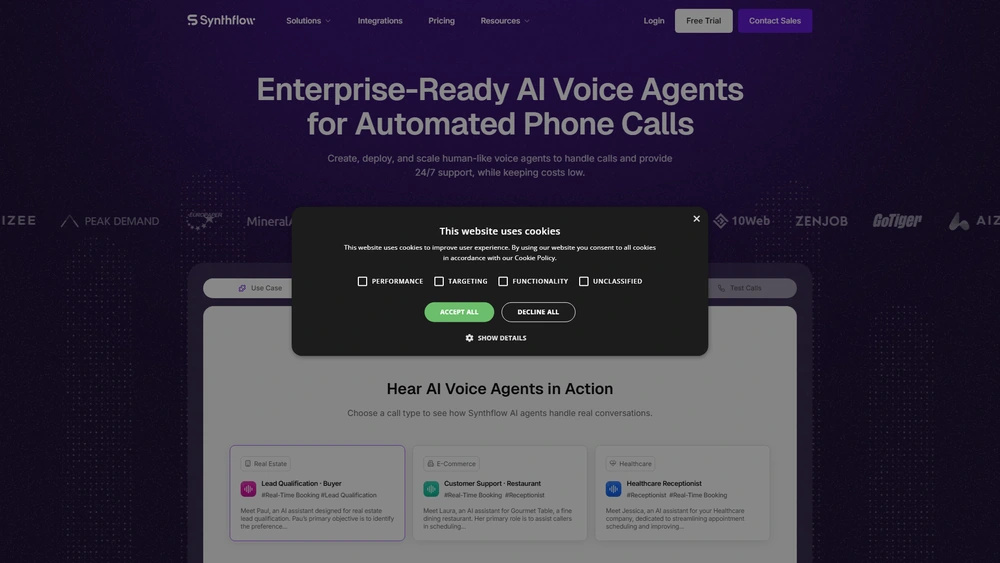Synthflow AI Overview & 2025 Industry Position
In the evolving landscape of voice automation, Synthflow AI has positioned itself as a leader in no-code AI voice experiences for businesses ranging from SMBs to enterprise sectors. Designed to democratize AI voice agents, Synthflow AI enables marketing, sales, and support workflows to be automated with minimal developer effort. As we step into the second half of 2025, the platform continues to expand its capabilities alongside growing market demand for hyper-personalized, AI-driven customer interactions.
Synthflow AI’s core offering is a visual builder that lets users design and deploy multichannel AI voice agents. With its API-friendly infrastructure and increasing integrations across CRM, payment, and e-commerce platforms, it’s become a preferred choice for businesses aiming to deliver seamless audio interactions without traditional overhead. As more mid-market players adopt AI to streamline voice engagement, Synthflow AI bridges performance and simplicity at scale.
From Launch to 2025: Synthflow AI’s Journey
Synthflow AI was founded in early 2021 with a bold mission to simplify AI-powered voice automation for businesses of all sizes. What began as a voicebot experiment quickly evolved into a scalable, no-code platform compatible with leading CRM and e-commerce ecosystems. The platform gained traction in 2022 after receiving seed funding and onboarding early adopters from the fintech and SaaS sectors.
- 2021 Q2: Company founded and first prototype launched.
- 2022 Q1: Secured pre-seed round; launched beta AI voice builder.
- 2023 Q3: Rolled out API integrations for Stripe, HubSpot.
- 2024 Q1: Introduced AI voice analytics dashboard.
- 2025 Q2: Launched Synthflow Studio 2.0 with multi-agent orchestration.
In July 2025, Synthflow AI is advancing with a 2025 strategy centered around cross-channel fluidity and real-time personalization—delivering autonomous agents that adapt conversations based on live CRM and behavioral data.

Synthflow AI Key Features
Synthflow AI centers around its powerful no-code voice builder, API extensions, and automation tools. Here’s a look at what sets it apart in 2025:
- No-Code Voice App Builder: Drag-and-drop interface to design voice agents with conditional logic, API calls, and multichannel triggers.
- Multi-Agent Support: Deploy multiple voice agents across campaigns, each with unique personalities, tones, and business functions.
- Live CRM & Database Linkage: Read/write data live from tools like Salesforce, Airtable, and Stripe during conversations.
- Smart Intent Routing: Natural language understanding (NLU) plus fallback pathways powered by OpenAI, Cohere, and Claude.
- Voice-to-Action Analytics: Real-time reporting on abandon rates, agent confidence scores, and conversion triggers.
Workflow & UX
The Synthflow AI interface is both fluid and intuitive. Users create agents using modular blocks: voice input, logic gates, text transformation, third-party data fetch, and voice outputs. Even without prior coding experience, users can fully deploy complex call flows, including dynamic variables and fallback logic.
Noteworthy UX elements include:
- Keyboard Shortcuts: For power users building large flows.
- Real-Time Simulation: Voice conversation tester with logging.
- Shared Templates: Pre-built use cases from the Synthflow AI community.
- Dark Mode & Focus Builder: Minimize distractions when working on calls.
Synthflow AI Pricing Analysis & Value Metrics
| Plan | Monthly Price | Voice Minutes | Features |
|---|---|---|---|
| Starter | $29 | 5,000 mins | 1 Agent, No-code Builder, Basic Integrations |
| Growth | $99 | 20,000 mins | Unlimited Agents, CRM Sync, API Extensions |
| Scale | $249 | 60,000 mins | Multi-Tenant, Inbound Routing, Premium Support |
| Enterprise | Custom | Unlimited | Custom SLAs, Dedicated AE, On-Prem Hosting |
Each plan offers competitively priced minute tiers compared to similar voice automation platforms, especially when factoring in millisecond response time and real-time personalization.
Competitive Landscape
The voice automation space is rapidly growing. Here’s how Synthflow AI stacks up:
- vs. Twilio Studio: Easier UX, no-code design, faster deployment.
- vs. Voiceflow: Stronger integrations & analytics; Voiceflow better for prototyping, Synthflow AI for production.
- vs. Dialpad AI: Synthflow AI is more customizable and adaptable to non-sales use cases.
Companies seeking scalable voice infrastructure with fluid user interfaces typically choose Synthflow AI over hard-coded workflows or tools requiring technical onboarding.
Common Use Cases
- Inbound Support Automation: Auto-triage support tickets from phone callers.
- Sales Qualification: Real-time lead scoring and routing based on voice interaction.
- Appointment Reminders: HIPAA-compliant agents for healthcare & clinic scheduling.
- Order Confirmation: Voice check-ins for e-commerce fulfillment and delivery updates.
Pros & Cons
- Pros:
- Highly intuitive voice builder
- Real-time integrations & live API logic
- Low code to no-code deployment options
- Transparent and cost-effective pricing
- Cons:
- Steep learning curve for advanced API routing
- Inbound voice still in beta for some regions
- Limited offline documentation in non-English languages
Pro Tip: Start with the Starter or Growth plan and clone a community template—it saves hours in first-time setup.
Synthflow AI FAQ
Yes, Synthflow AI offers a native Salesforce integration for real-time field reads, contact creation, and list syncing during voice calls.
Synthflow AI offers HIPAA-compliant deployment options for healthcare use cases, available on Scale and Enterprise plans.
Most companies report ROI within 90 days due to reduced inbound call handling costs and increased lead qualification efficiency.
Yes. Users can download flow JSONs and re-upload them on another workspace or account, enabling team portability.
Synthflow AI supports multilingual voice agents with language-specific logic, including Spanish, French, and German.